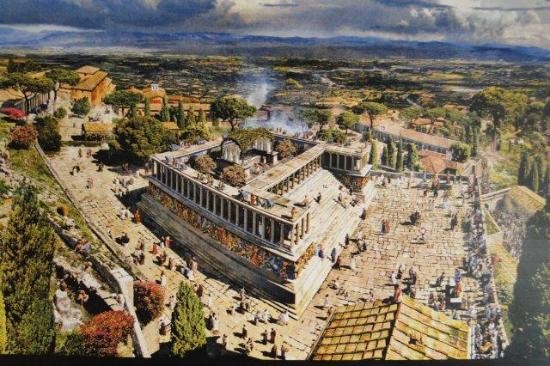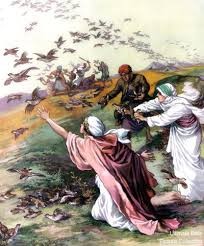The Church in Pergamos

Reveals who Jesus is:
“And to the angel of the church in Pergamos write; These things saith he which hath the sharp sword with two edges.” (Revelation 2:12). Pergamos is a city of Mysia Minor, in Asia Minor, the seat of the dynasties of Attalus and Eumenes, famous for its temple of Aesculapius and the invention and manufacture of parchment. The river Selinus flowed through it and the Cetius ran past it. It was the birthplace of the physician Galen, and had a great royal library. It had a Christian church. (Strong. 2001. #4010).
The city of Pergamos is about sixty-five miles to the north of Smyrna and fifteen miles from the Aegean Sea it is modern day city of Bergama. Pergamos is located at an elevation of about one thousand feet, Pergamum served as a stronghold that dominated the countryside. It was a city of prominence in the centuries before the Romans invaded and made it a capital. Pergamum was known as a religious center, with the temple of Athena was the altar of Zeus. It was the most splendid of religious monuments because of its height—some forty feet. Asclepius was the god of healing and attracted the interest of countless people suffering physical ills. His symbol was the snake, which still decorates medical emblems today. After the Romans conquered Pergamum, they built a temple in 129 B.C. Later they dedicated the temple to Augustus and Rome, and introduced the worship of Caesar. (Kistemaker.2001 pgs 120-122).
The Scriptures tells us the word of God is sharper than a two-edged sword (Hebrews 4:12). We also know that out of the mouth of Jesus came a sharp two-edged sword (Revelation 1:16). Jesus is also depicted that out of His mouth comes a sharp sword, that with it he should smite the nations: and he shall rule them with a rod of iron: and he treads the winepress of the fierceness and wrath of Almighty God. And He has on his vesture and on his thigh a name written, KING OF KINGS, AND LORD OF LORDS. (Revelation 19:15-16).
Jesus Rebuke and admonished the church of Pergamos:
The message sent to the angel of the church in Pergamum from the Lord Jesus Christ, was: “I know where you live, where Satan’s throne is. Yet you are holding on to my name, and you did not renounce your faith in me, even in the days of Antipas, my faithful witness, who was killed among you where Satan lives.” (Revelation 2:13).
The church in Pergamene believers were surrounded by pagan worship, yet they held fast to Christ’s name and did not deny Him during difficult times. If they refused to accept an invitation to attend a feast in honor of a pagan deity, they would not only be shunned, but they would lose their jobs or businesses. People would call them outcasts not fit to live on this earth. But for faithful believers there is no one higher than their Lord, no human law that takes precedence over God’s law, and no teaching that supplants the gospel. One Christian in Pergamum, named Antipas was my faithful martyr, who was slain among you, where Satan dwells. Church tradition says that Antipas was a physician suspected of secretly propagating Christianity. The Aesculapians (members of the medical guild) accused Antipas of disloyalty to Caesar. Upon being condemned to death, Antipas was placed inside a copper bull, which was then heated over a fire until it was red-hot. (Logos. 2010).
But I have a few things against thee, because thou hast there them that hold the doctrine that is doctrine, teaching, concerning something (Strong. 2001. #1322) of Balaam, a native of Pethor a city in Mesopotamia, endued by Jehovah with prophetic power. He was hired by Balak to curse the Israelites; and influenced by the love of reward, he wished to gratify Balak; but he was compelled by Jehovah’s power to bless them. Hence later the Jews saw him as a most abandoned deceiver. (Strong. 2001. # 903), who taught Balak, a king of Moab (Strong. 2001. # 904), to cast a stumblingblock which is defined as; 1) any impediment placed in the way and causing one to stumble or fall, (a stumbling block, occasion of stumbling) i.e. a rock which is a cause of stumbling. 2) fig. applied to Jesus Christ, whose person and career were so contrary to the expectations of the Jews concerning the Messiah that they rejected him and by their obstinacy made shipwreck of their salvation (Strong. 2001. # 4625), before the children of Israel, to eat things sacrificed unto idols, and to commit fornication which is 1) to prostitute one’s body to the lust of another; 3) metaph. to be given to idolatry, to worship idols. (Strong. 2001. # 4203). (Revelation 2:13).
Jesus told the church in Pergamos that there were a few things that He had against them. The first one was they held the teachings of Balaam which is false teachings and conduct within the church. The story of Balaam and Balak is found in Numbers 22-25. “Balaam taught Balak to put a stumbling block before the Israelites to make them eat food offered to an idol and commit fornication.” It is suggested that after Balaam’s triple failure to curse the Israelites, he lured them into committing adultery with Midianite women, eating meat offered to idols, and worshiping pagan. The teachings of Balaam were not so much doctrine as practice: indulging in sexual immorality with Moabite women, the eating of food sacrificed to idols, and the worship of these idols (Numbers 25:1–3; Psalms 106:28). This was the stumbling block that Balak, following Balaam’s advice, placed before the people of Israel to make them fall into sin. The Israelites were invited to participate in the pagan fertility rites of the Moabite people, whose women enticed the Israelite men to engage in sexually immoral acts. This stumbling block brought about death for the Israelites: a plague struck and killed some twenty-four thousands of them (Numbers 25:9; 1 Corinthians 10:8).
“So hast thou also them that hold the doctrine of the Nicolaitans, who were charged with holding the error of Balaam, casting a stumbling block before the church of God by upholding the liberty of eating things sacrificed to idols as well as committing fornication (Strong. 2001. # 3531), which thing I hate.” (Revelation 2:13-15).
The doctrine of the Nicolaitans suggested that the church in Pergamos participated in sexual immorality. Jesus calls the church in Pergamum to repent for tolerating some among them who held to Nicolaitans teaching. Jesus compared the Nicolaitans to the Balaam and Balak group, which pressed people into eating meat sacrificed to idols and sexual immorality. The church in Pergamos knew the laws of the LORD that would band them from practicing any extramarital sexual relationships and to avoid eating meat sacrificed to idols. The church in Pergamos knew that the practices and the teachings of the Nicolaitans were an abomination to Jesus.
Jesus warns the church in Pergamos:
“Repent that is to change one’s mind for better, heartily to amend with abhorrence of one’s past sins (Strong. 2001. # 3340); or else I will come unto thee quickly, and will fight against them with the sword of my mouth.” (Revelation 2:16).
The Church in Pergamum had to repent of their failure to expel the Nicolaitans out of their midst as well as those who chose to be followers of Nicolaitans. They were expected to see the error of their way and their followers from among them. They had to see the error of their ways and repent and turn back to the Lord Jesus Christ.
Jesus warns them if they do not repent then He would come unto them quickly and would fight against them with the sword of His mouth. Jesus called the church in Pergamos to repentance but He declares war on the Nicolaitans. Jesus warns the church in Pergamos He would fight them with the double-edged sword that proceeds from his mouth, and with this sword Jesus would slay the wicked, the Nicolaitans and their followers. This would come quickly without delay. The church in Pergamos were to react quickly to repent and remove the evil that pledged inside their church.
Jesus Promises the church in Pergamos He that hath an ear, let him hear what the Spirit saith unto the churches; To him that overcometh will I give to eat of the hidden [metaph. to conceal that it may not become known (Strong. 2001. # 2928)] manna symbolically, that which is kept in the heavenly temple for the food of angels and the blessed (Strong. 2001. # 3131), and will give him a white stone, and in the stone a new name written, which no man knows saving he that receive it. (Revelation 2:17).
The promise of Jesus for those who overcomes is they will be given to eat of the hidden manna. Those who overcomes from the church in Pergamos also will receive a white stone and a new name would be written on it. No man will know this new name except the one who receives the new name. The white stone would represent the pure state of victory over sin and death.
The children of Israel wandered in the wilderness for forty years until they came to a land inhabited; they did eat manna, until they came unto the borders of the land of Canaan. The LORD God provided manna from heaven for the survival of His chosen children. The LORD God instructed Moses to place a jar of manna in the Ark of the Covenant. This was to be kept for their generations; that they may see the bread wherewith the LORD God have fed them in the wilderness, when He brought you forth from the land of Egypt. (Exodus 16:32–34). Hebrews 9:4 confirms; “Which had the golden censer, and the Ark of the Covenant overlaid roundabout with gold, wherein was the golden pot that had manna, and Aaron’s rod that budded, and the tables of the covenant.”
There is only one reference to God giving us a white stone with a new name: “To the one who is victorious, I will give some of the hidden manna. I will also give that person a white stone with a new name written on it, known only to the one who receives it” (Revelation 2:17). It is not exactly known the meaning of the white stone and the new name engraved on the white stone. It could be the name of Jesus, the name of the LORD God, or the new name of the person who had victoriously overcome the church in Pergamos. It doesn’t matter which way this verse is interpreted there is only one fact that is revealed; only the person who receives this stone will know the name that is written on it.
References:
Kistemaker, Simon J. and Hendriksen, William. (2001). Exposition of the Book of Revelation, vol. 20, New Testament Commentary. Grand Rapids: Baker Book House.
Logos. (2010). Got Questions Ministries, Got Questions? Bible Questions Answered. Bellingham, WA: Logos Bible Software.
Strong, James. (2001).The New Strong’s Expanded Exhaustive Concordance of the Bible. Nashville: Thomas Nelson Publishers.
Cite Article Source
MLA Style Citation:
Holstein, Joanne “The church in Pergamos:.” Becker Bible Studies Library June 2015.<https://guidedbiblestudies.com/?p=2888,>.
APA Style Citation:
Holstein, Joanne (2015, June) “The church in Pergamos:.” Becker Bible Studies Library. Retrieved from https://guidedbiblestudies.com/?p=2888,.
Chicago Style Citation:
Holstein, Joanne (2015) “The church in Pergamos:.” Becker Bible Studies Library (June), https://guidedbiblestudies.com/?p=2888, (accessed).


